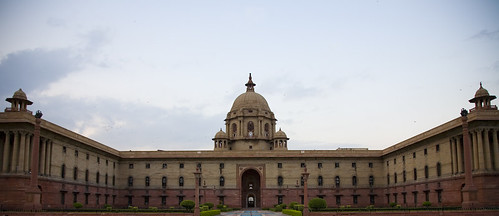Terence Kealey is an emeritus professor of clinical biochemistry at the University of Buckingham.
All Conservatives will want to know what went wrong in India under the rule, first of the British East India Company and then, after 1858, of the British Raj.
For a long time the essential British position has been one of self-praise, with Conservatives in particular producing a stream of imperial apologists.
Their apologetics have been so well received that, to a happy degree, their authors have been honoured by our party.
So, in his Empire: How Britain Made the Modern World, Sir Niall Ferguson portrays the British in their pith helmets as harbingers of modernity, bringing enlightenment to the benighted natives of the East; while in his Victorians: Twelve Titans Who Forged Modern Britain, Sir Jacob Rees-Mogg identifies three individuals in particular—General Gordon, William Sleeman and Queen Victoria herself—whose efforts were especially prized by colonials all over the world including in India.
Going up the Tory order of precedence, Lord Andrew Roberts’s History of the English-Speaking Peoples Since 1900 is a splendid encomium to empire (and is rude about Gandhi), while Lord Nigel Biggar’s Colonialism: A Modern Reckoning was lauded by no less an authority than ConservativeHome itself.
But there is worm in this apple of British self-praise, namely Indian GDP per capita, because we British governed the subcontinent for two centuries, yet—while we created an Industrial Revolution at home—standards of living in India under our rule fell, really quite severely, culminating in the famine of 1943, when three million Bengalis died of starvation.
In his book Inglorious Empire: What the British Did in India, Shashi Tharoor, the Indian MP and public intellectual, damns amongst other British malfeasances the Calico Acts.
The Acts prohibited the import of finished Indian textiles into Britain when those finished textiles were the best in the world. But the Acts did not prohibit the import of Indian raw cotton. So, Tharoor claims, we British launched our Industrial Revolution by importing raw cotton from India to Manchester, there to finish it by using techniques in spinning, weaving and printing we stole from the Indians. The Indians having thus lost their technologies as well as their markets to the British, it’s no wonder their GDP per capita fell under imperial rule.
Though these narrative threads from Ferguson, Rees-Mogg, Roberts, Biggar and Tharoor are all, in their different ways true, none of these authors provides a comprehensive overview of what the British did in India. For that we have to turn to An Economic History of India: Growth, Income and Inequalities from the Mughals to the 21st Century, which was published earlier this year by Professor Bishnupriya Gupta, an economist at Warwick University. And, unlike the narrative historians, Gupta is an auditor who’s done the maths.
The reality is that the textile industry was tiny relative to India’s major industry, namely agriculture, so it didn’t much matter what the weavers, spinners and printers did or did not get up to: if agriculture succeeded (as it had under Emperor Akbar during the 16th century), then India succeeded. But if agriculture failed (as it did under the British), then India failed. And agriculture failed under the British for the most mundane of reasons: we didn’t irrigate sufficiently.
India is a land of seasonal rainfall, so if it doesn’t build dams, sluices and canals, then—during the dry seasons—its crops and livestock will shrivel in the fields.
The British could certainly build infrastructure in India, particularly the railways, for those were useful to the military and to British extractive interests—trains were particularly important to the opium trade—but the colonisers built too few waterways because they would not be of importance to British businesspeople: they would be of importance only to ordinary Indians, in whom the British were insufficiently invested. The civil servants of the Raj—aware of the taxes they raised on the peasantry—would have lobbied for agricultural irrigation, but they would have been sidelined by British plutocrats looking for quicker and more private bucks.
Gallingly, other colonialists were better curators of their colonies. It emerges from Gupta’s book, for example, that Japan’s much-vaunted Greater East Asia Co-Prosperity Sphere wasn’t just propaganda but, rather, the real thing: Japan irrigated its colonies in Korea and Taiwan intensively, thus laying the foundations for those two countries’ eventual economic miracles. But in a demonstration of Amartya Sen’s thesis that food security depends on responsive government, it was only following our departure in 1947 that Indian agriculture started to recover. The onset of that recovery was, however, delayed until 1952 by the lack of infrastructure; and not until 1967, twenty years after independence, did Indian GDP per capita finally recover to the level of 1600. India thus experienced three and two thirds’ locust centuries.
Professor Gupta’s book is composed for academics, so it can’t be recommended lightly to civilians.
Yet it is written delightfully, it is short, and with time even the most civilian of civilians learns to pass over Cambridge University Press’s pedestrian system of references, which can clog entire lines of text. And there are advantages to a book being composed for academics, because it skips the free trade propaganda that so many economists feel they have to push when writing for the general public.
Niall Ferguson’s ‘modernity’ was code for globalisation, which could be disastrous for a poor country like India trying to grow its infant industries. Gupta, however, notes as a simple matter of fact, as one informed adult to another, how tariffs, if applied with discrimination, can be integral to development in the third world, just as they had been in Manchester under the regime of the Calico Acts (1700-1774), so it is a relief to be addressed over tariffs as a fellow adult who can cope with the heresy that free trade is not always good trade.
Anyone who is seriously interested in what went wrong under in India under the British should read this book.
Everyone else, meanwhile, who has been more casually misled by the Tory apologists or Shashi Tharoor, need only remember that we failed the subcontinent because it wasn’t in our commercial interests to irrigate it properly.




![Man Arrested After Screaming at Senators During Big Beautiful Bill Debate [WATCH]](https://www.right2024.com/wp-content/uploads/2025/06/Man-Arrested-After-Screaming-at-Senators-During-Big-Beautiful-Bill-350x250.jpg)












